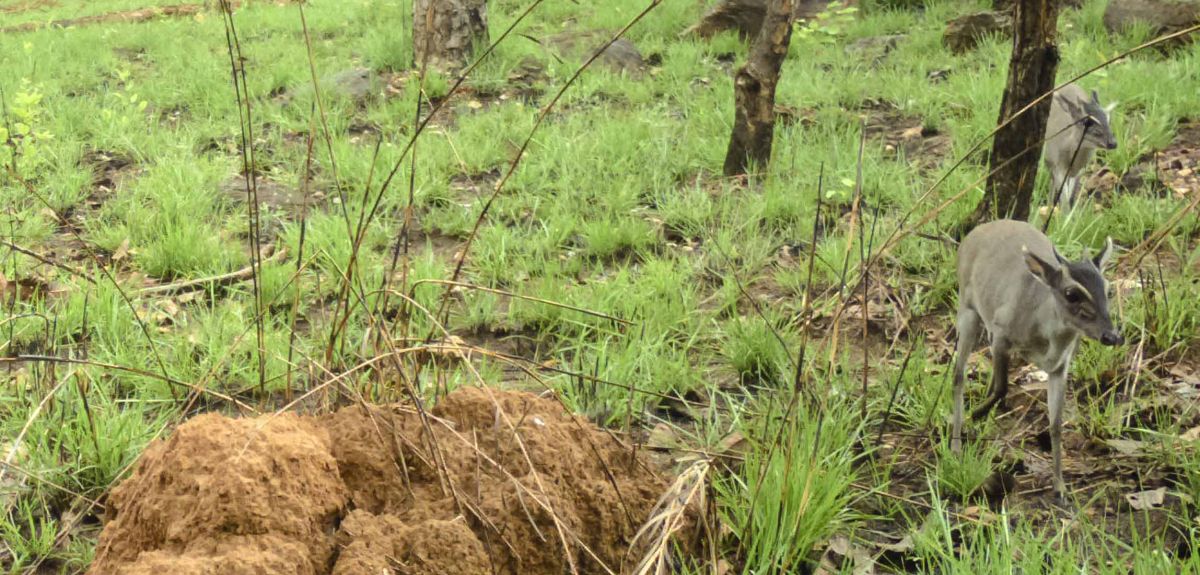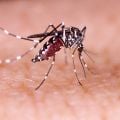
© Assou et al., 2021
One of the world’s most secretive mammals photographed in WildCRU’s Togo survey
Researchers at the Wildlife Conservation Research Unit (WildCRU), University of Oxford, today confirmed that it has captured the first ever images of Walter’s duiker (Philantomba walteri) alive in the wild.
This small African antelope has hitherto been secretive to the point of invisibility. The WildCRU study, published today in African Journal of Ecology, was led in Togo by local mammologist, Délagnon Assou, with the base team led by Dr Neil D’Cruze, and shows a stunning picture of an animal which has never been photographed alive in the wild before.
This startling first image of a Walter’s duiker in the wild was part of an even wider first: the first comprehensive remote camera trapping survey for mammalian mega fauna ever undertaken in Togo (West Africa) spanning over 9,000 days of monitoring.
This graceful antelope has, for the last 200 years, displayed a great talent for avoiding scientists, but proven tragically less adept at avoiding nets, snares and hunting dogs.
The joint Togolese / British / German team of scientists placed 100 camera traps in the Fazao-Malfakassa National Park, the largest protected area in the country. They were astonished and delighted to capture this image of a Walter’s duiker, but also recorded several other endangered and endemic species.
Walter’s duiker is an excitement because, against a background of species going extinct, this one was only just discovered: adding a welcome plus to the profit-and-loss account of biodiversity only in 2010. Its previous existence was embodied only in skulls and carcasses spotted in bush meat markets in Benin, Togo and Nigeria and its conservation status on the IUCN Red List (a directory of species’ endangerment) is euphemistically logged as “Data Deficient”, with its population trends summarized as “unknown”.
Professor David Macdonald, WildCRU’s Director said: ‘This graceful antelope has, for the last 200 years, displayed a great talent for avoiding scientists, but proven tragically less adept at avoiding nets, snares and hunting dogs.
‘Plotting their whereabouts in bushmeat markets is roughly analogous to plotting the habits of deer in the UK by mapping their occurrence on butchers’ slabs. Camera ‘trapping’ revolutionises biological survey: an army of cameras sits patient and uncomplaining, immobile for months on end, awaiting an interesting passer-by.’
Bushmeat trade is the commercial hunting and selling of wild animals for food. It differs in scale from subsistence hunting: the killing of wild animals for food for a family or village. Bushmeat trade is recognised as a major driver of biodiversity loss, a risk to animal welfare, and public health.
We hope our exciting find – the first live image of Walters Duiker in the wild - will increase the call for further protection of our remaining forest and savannah
Dr Gabriel H. Segniagbeto, Associate Professor of taxonomy and zoological systematic at the University of Lomé, said: ‘It is critically important to recognize the importance of the protected area system of Togo, which acts as a vital stronghold for a rich diversity of wild mammals. We hope our exciting find – the first live image of Walters Duiker in the wild - will increase the call for further protection of our remaining forest and savannah.’
Based on images compiled from the camera trapping in the Fazao-Malfakassa National Park, the study identified 32 mammal species, which, when combined with other published studies, increases the total number of mammals (excluding bats) historically reported to 57 species.
Professor David Macdonald said: ‘This is the way to find needles in a metaphorical haystack. It also instantly shines a global focus on this important national park in Togo. Along with Walter’s duiker we also found aardvarks and a mongoose called cusimanse, neither of which have previously been recorded in Togo.
‘A special bonus of this study is that its Togolese inspiration, Délagnon Assou, will, as soon as covid allows, be travelling to Oxford to study on WildCRU’s famous diploma course.’
Along with Walter’s duiker we also found aardvarks and a mongoose called cusimanse, neither of which have previously been recorded in Togo
For ecologists studying the interactions between species, and the relationships that link the working parts of communities of animals, it is of note that the team discovered that the Fazao-Malfakassa National Park appears to be the only protected area in Togo where the African savanna elephant and the African forest elephant occur together.
However, this National Park is threatened by a number of illegal activities including hunting, cattle grazing, timber exploitation, bush fires and agricultural encroachment. Since the late 1980s closed-canopy forest and tree-savannah has become severely degraded and fragmented within the park.
 New study estimates NHS England spends 3% of its primary and secondary care budget on the health impacts of temperature
New study estimates NHS England spends 3% of its primary and secondary care budget on the health impacts of temperature
 International collaboration launches largest-ever therapeutics trial for patients hospitalised with dengue
International collaboration launches largest-ever therapeutics trial for patients hospitalised with dengue
 Oxford-built multi-agent assistant for cancer care to be piloted in collaboration with Microsoft
Oxford-built multi-agent assistant for cancer care to be piloted in collaboration with Microsoft
 World's first Phase II Nipah virus vaccine trial launch
World's first Phase II Nipah virus vaccine trial launch